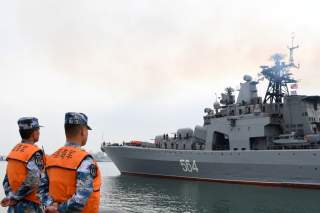The Pentagon And Japan Just Exposed A Secretive Chinese Naval Militia
China is pursuing asymmetric means to reach its goals in Asia.
American and Japanese analysts and decision-makers should therefore redouble their efforts to share information and develop and implement potential countermeasures concerning the PAFMM. Here, as elsewhere, sunlight is the best disinfectant and demonstrated awareness is an important element of deterrence. Just as the Pentagon’s 2017 report was the first iteration to mention the PAFMM and this latest 2018 edition builds strongly on that foundation, it is to be hoped that the Japan Ministry of Defense’s Defense of Japan 2017 report—which likewise mentioned the PAFMM for the first time, albeit without explicit in-text reference to the East China Sea—will be followed with a 2018 edition offering far more robust PAFMM coverage, including detailed consideration of extant and potential future activities in the East China Sea.
As mentioned above, the Pentagon’s latest report also stresses PAFMM involvement in the layered cabbage-style envelopment of the Philippines-claimed Sandy Cay shoal near Thitu Island in the South China Sea, although it does not mention the fact—confirmed by commercially available AIS data concerning ship movements—that China has sustained a presence of at least two PAFMM vessels around Sandy Cay since August 2017. As the Pentagon emphasizes, the “PLAN, CCG, and PAFMM sometimes conduct coordinated patrols.” Inter-service cooperation applies in peace and war: “In conflict, China may also employ China Coast Guard and People’s Armed Forces Maritime Militia ships to support military operations.”
“In the South China Sea,” the report emphasizes, “the PAFMM plays a major role in coercive activities to achieve China’s political goals without fighting, part of broader PRC military doctrine stating confrontational operations short of war can be an effective means of accomplishing political objectives.” Other CMSI-documented examples of international incidents involving the PAFMM there that the report does not mention explicitly include direct participation in China’s 1974 seizure of the Western Paracel Islands from Vietnam; involvement in the occupation and development of Mischief Reef resulting in a 1995 incident with the Philippines; harassment of various Vietnamese government/survey vessels, including the Bin Minh and Viking; participation in the 2014 blockade of Second Thomas Shoal; and engagement in the 2015 maneuvers around USS Lassen.
In conclusion, the Pentagon deserves great credit for employing the full force of its tremendous analytical capabilities and official authority to shine a bright, inescapable spotlight on the PAFMM’s true nature and activities. There is no plausible deniability: the PAFMM is a state-organized, -developed, and -controlled force operating under a direct military chain of command to conduct PRC state-sponsored activities. Publicly revealing the PAFMM’s true nature and activities is an important step in deterring its future use. But far more is needed to counter the pernicious challenge of Beijing’s shadowy but fully knowable third sea force. As the Pentagon’s valuable new report emphasizes, “China continues to exercise low-intensity coercion to advance its claims in the East and South China Seas.”
Dr. Andrew S. Erickson is a professor of strategy in the U.S. Naval War College (NWC)’s China Maritime Studies Institute (CMSI) and an Associate in Research at Harvard University’s John King Fairbank Center for Chinese Studies. Since 2014, he and his colleague Conor M. Kennedy have been conducting and publishing in-depth research on the People’s Armed Forces Maritime Militia (PAFMM) and briefing key U.S. and allied decision-makers on the subject. In 2017 Erickson received NWC’s inaugural Civilian Faculty Research Excellence Award, in part for his pioneering contributions in this area.
This article first appeared in August 2018. It is being republished due to reader interest.
Image: Reuters.

